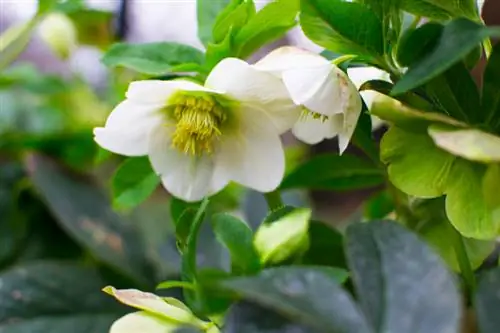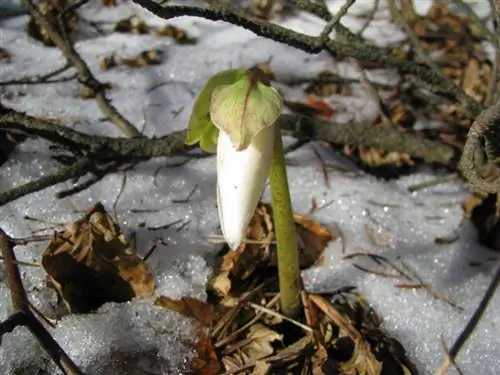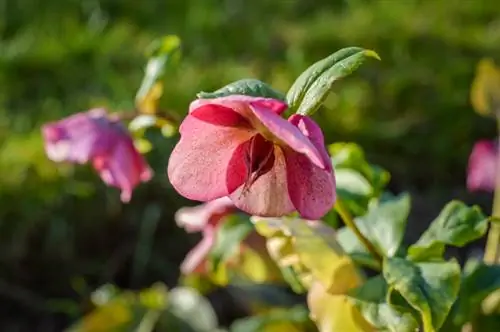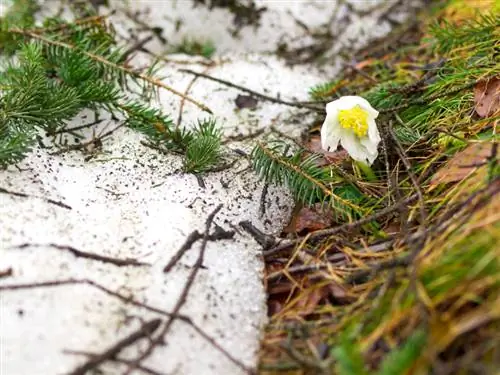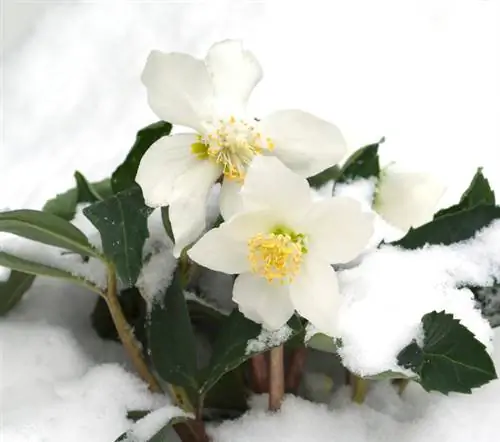- Author admin [email protected].
- Public 2023-12-25 17:45.
- Last modified 2025-01-23 11:22.
The snow rose impressively demonstrates the power of Mother Nature with its winter blooms. Read here how the Christmas rose can perform the flower miracle in your garden in the midst of ice and snow.

When does the Christmas rose bloom and what conditions does it prefer?
The Christmas rose, also known as the snow rose or Christmas rose, is a winter-flowering perennial that usually presents its breathtaking flowers from November to February. It prefers partially shaded to shady locations, nutrient-rich, calcareous and fresh, moist soils.
Planting Christmas roses correctly
The snow rose lives up to its reputation as an easy-care ornamental perennial if you take these aspects into account when planting:
- Situate in a partially shaded location in nutrient-rich, permeable and calcareous soil
- Soak the root ball in water while loosening and weeding the soil
- Dig a pit with 1.5 times the volume of the root ball
- Enrich the soil with compost (€10.00 on Amazon), horn shavings and vital lime
Unpot the soaked Christmas rose and plant it in the optimized soil up to the root collar. Press the substrate with your hands, water and mulch. Be sure to wear gloves during the entire procedure due to the high toxic content.read more
Care tips
A Christmas rose requires only a small amount of care so that it can present its breathtaking blooms in winter. How to properly treat the robust ornamental perennial:
- When it is dry, water regularly with normal tap water
- Fertilize from November to February with compost or liquid fertilizer
- Work vital lime or rock dust superficially into the soil every 4 weeks
- Permanently provide a 3-5 cm thick layer of mulch made from leaves, coarse compost or bark mulch
- Cut off the wilted flower stems and the drawn-in foliage in early summer at the latest
The mulch cover acts as winter protection in the bed, supplemented by the autumn leaves that have been left lying around. Cover a bucket with foil or jute ribbons.read more
Which location is suitable?
For the winter flower miracle to actually come true, the most important thing is to choose a suitable location. Plant the Christmas rose in this location:
- Partly shaded to shady, wind-protected location
- Without direct sunlight
- Nutritious, fresh, moist and, above all, calcareous soil
Cultivate the snow rose on the windowsill at home in a bright place with temperatures not exceeding 15 degrees Celsius. After flowering, the perennial belongs in the cool shade of the garden.read more
The correct planting distance
Plant the pure species Helleborus niger at a distance of 35 centimeters, so that no more than 8 specimens should be arranged per square meter. If it is a taller growing hybrid of Christmas rose and Lenten rose, a distance of 50 centimeters is considered appropriate.
What soil does the plant need?
The condition of the soil contributes significantly to the vital growth and rich flowering of a snow rose. Value these qualities:
- Nutritional, humic and calcareous
- Fresh-moist, preferably loamy and well-drained
Good quality compost-based potting soil, enriched with sand, lava granules and a handful of vital lime or rock dust, is suitable for pot cultivation.
What is the best time to plant?
Plant the Christmas rose in autumn in soil warm from the sun. At this time the ground has warmed up to 17 degrees, so that the roots of a snow rose can quickly establish themselves. Alternatively, choose spring as the planting date, ideally between mid-April and mid-May.read more
When is flowering time?
After the first glimpse of a snow rose in bloom, hobby gardeners rub their eyes in amazement. The ornamental perennial blooms at a time when the other plants in the garden remain in deep winter dormancy. The central flowering period extends from November to February. Some modern varieties bloom into April in mild years, such as the double 'Double Fashion'.read more
Cut Christmas rose correctly
The Christmas rose does not require regular pruning. In spring, cut off the withered flower stalks so that the flower does not invest its energy in the formation of seed heads. The leaves are only removed close to the ground when they have completely been absorbed. Until then, the plant assimilates all remaining nutrients in order to use them in the next flowering period.read more
Water Christmas rose
During its flowering period, the Christmas rose requires a sufficient supply of water. If a blanket of snow does not spread to provide water, water regularly on frost-free days. Also keep an eye on the ornamental perennial in summer, because the root ball should not dry out outside of the flowering period.
Fertilize Christmas roses properly
In the open field, the Christmas rose is content with a nutrient-rich mulch layer made of mature compost, horn shavings, leaves or grass clippings. If the location is under deciduous trees, leave the fallen leaves lying in autumn so that they turn into valuable humus. In the planter, fertilize the snow rose with a commercially available liquid fertilizer during the flowering period.read more
Wintering
The Christmas rose is completely hardy in the bed. If you mulch consistently with leaves, compost or straw during the cold season, this measure is sufficient as winter protection. In the pot, however, there is a risk that the root ball will freeze. Therefore, cover a planter with bubble wrap and place it on insulating material such as wood or Styrofoam.read more
Propagate Christmas roses
Propagation of a Christmas rose is easy and simple by dividing it. In spring or autumn, do this:
- Tie the leaves loosely together with a raffia ribbon
- Push a pitchfork through the middle of the root ball
- Place the second pitchfork just below the first one
- Move both pitchforks back and forth to divide the rhizome
- Plant at the new location without any delay
Alternatively, harvest the ripe fruits in early summer to remove the seeds. This form of breeding is only suitable if you are not aiming for pure propagation. Since these are cold germinators, subject the seeds to stratification for four to six weeks in the vegetable compartment of the refrigerator or place the seed container on the balcony throughout the winter. In spring you can look forward to the first seedlings. It takes 3-4 years for the first flower to bloom.read more
How do I transplant correctly?
Only replant the Christmas rose if this measure is unavoidable. Any change of location carries the risk of total failure. Autumn and spring are possible dates. You increase the chances of success if as much root mass as possible is retained. In addition, the planting depth should be maintained at the new location.read more
Christmas rose in a pot
So that the snow rose looks its best in the pot, choose a container shape that offers enough space for the deep-rooted plant and has an opening in the bottom for water drainage. Drainage made of grit, expanded clay or pottery shards at the bottom of the pot prevents unwanted waterlogging. As a substrate, you should preferably use a mix of potting soil, compost, sand and perlite or lava grit. This is how you care for your Christmas rose in an exemplary manner:
- Water thoroughly until the water runs out of the bottom opening
- Empty the coaster after 10 minutes at the latest
- Let the soil dry out until the next watering
- During the flowering period, fertilize liquidly every 14 days
- Before the first frost, cover the pot with bubble wrap
Cut off the withered flowers in spring. Leave the decorative foliage on the flower until it has withered completely. Throughout the summer, place the plant in a shady spot in the garden and water enough to prevent the root ball from drying out. If you bring the snow rose into your house during the Christmas season, it will only bloom in a bright, cool place with temperatures between 10 and 15 degrees Celsius.read more
Is Christmas rose poisonous?
The botanical assignment of a snow rose to the plant family of the buttercup family and genus hellebore immediately makes experienced hobby gardeners sit up and take notice. These plants are all very poisonous to humans and animals. Only include the Christmas rose in your garden design if children and pets are kept out of reach. Plant and care for the ornamental perennial only with protective gloves.read more
Christmas rose not blooming
If the flowering fails, take a closer look at the cultivation of a snow rose for the following reasons:
- Wrong planting time: put a Christmas rose in the ground in autumn, in the ground by September at the latest
- Intense sunlight: the snow rose blooms in partially shaded areas
- Acidic pH: plant the Christmas rose in calcareous soil to encourage it to bloom
A young Christmas rose sometimes takes 1-2 years until it blooms for the first time. The beauty of the flowers makes up for this fact by blooming more magnificently from year to year.read more
Is the snow rose suitable as a houseplant?
The Christmas rose fulfills its actual purpose as a winter-flowering perennial in the bed. However, there is nothing wrong with integrating them into your home decorations at Christmas time. If you place the snow rose in a partially shaded location with temperatures between 10 and 15 degrees, the flowers will not take long to appear. However, the winter beauty doesn't feel comfortable in the cuddly warm living room.
Is the Christmas rose poisonous to cats?
In the interest of your cat, you should refrain from cultivating a snow rose as a bed or house plant. The buttercup plant is so poisonous in all its parts that it can endanger the life of your kitty if she nibbles on it curiously.read more
Trivia
The literal translation of the botanical name Helleborus niger means black hellebore. This name refers to the earlier use of the ground black roots of a snow rose as a sneezing powder. With this joke, vengeful pranksters drove their 'victim' to despair with sneezing attacks. Due to the high toxic content, modern versions of the product contain other ingredients.
Beautiful varieties
- Jacob Royal: white-flowering variety from the Helleborus Gold Collection, strong and stable
- Joel: blooms bright white from November and scores with a compact habit
- Double Fashion: double Christmas rose with an extra long flowering period from December to April
- Candy Love: magical snow rose with pink-white flowers and a height of up to 50 cm

